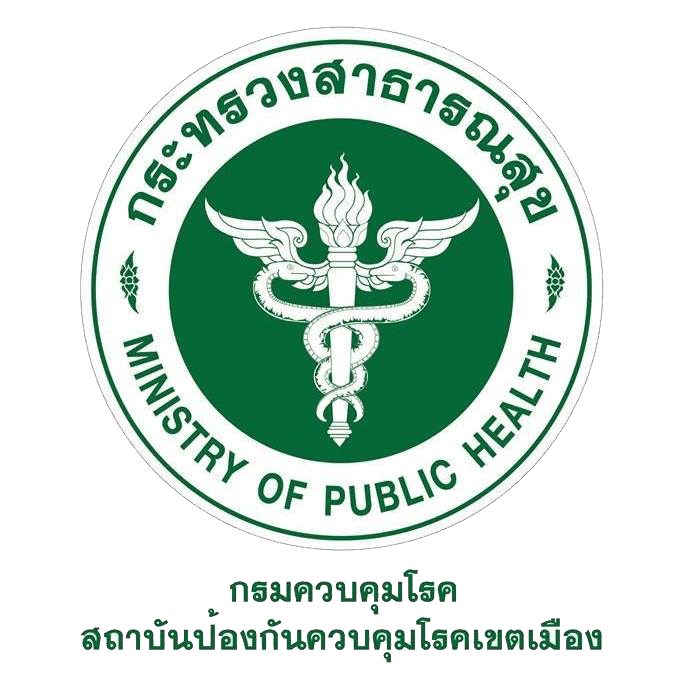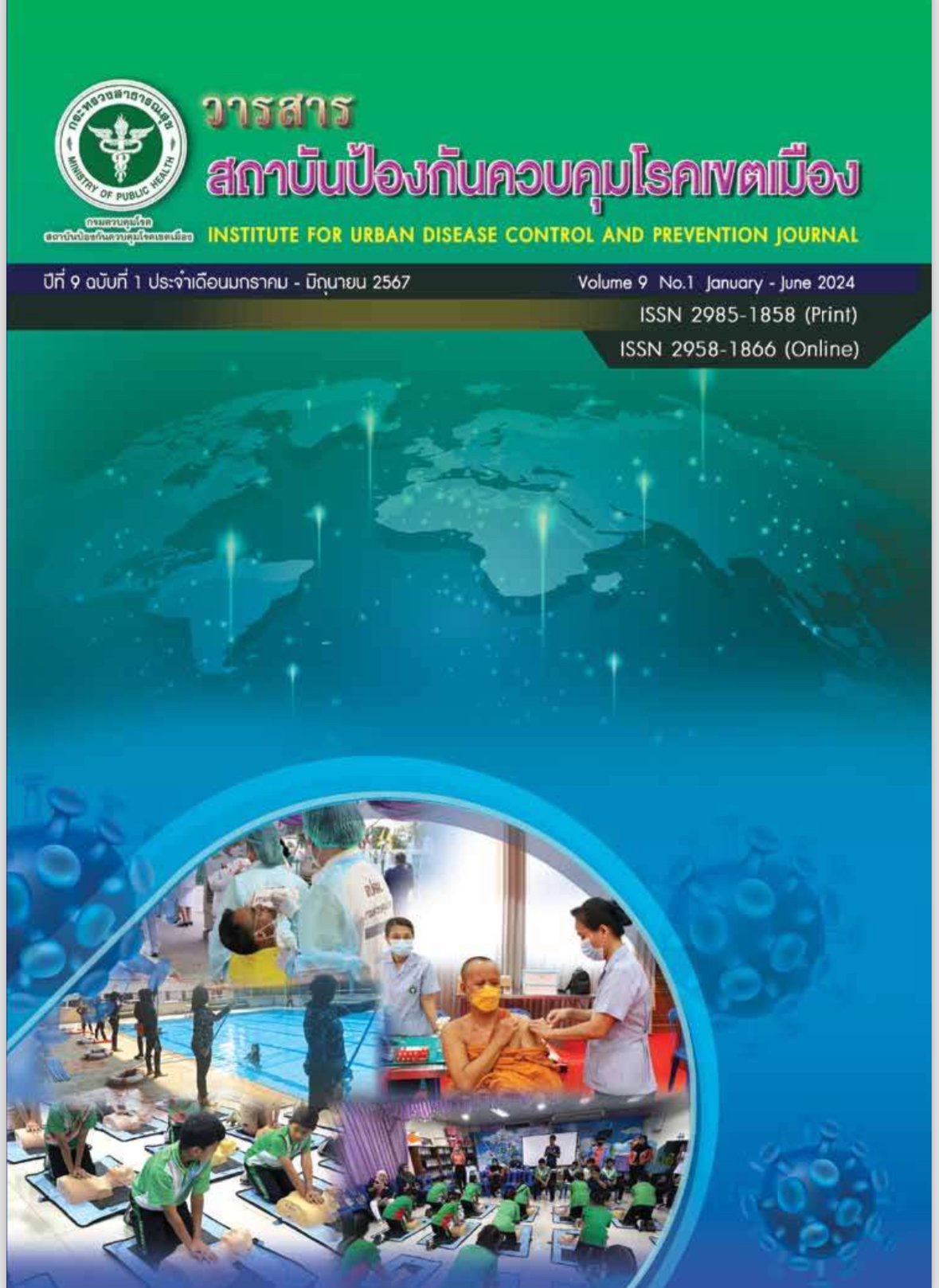ลักษณะทางระบาดวิทยาและปัจจัยเสี่ยงของการระบาดแบบกลุ่มก้อนของโรคอาหารเป็นพิษ และโรคอุจจาระร่วงเฉียบพลันในประเทศไทย ระหว่างปี พ.ศ. 2561 - 2565
Main Article Content
บทคัดย่อ
โรคอาหารเป็นพิษและโรคอุจจาระร่วงเฉียบพลันเกิดจากการปนเปื้อนจุลินทรีย์ก่อโรคหรือสารพิษ โดยที่เชื้อ
ก่อโรคอาหารเป็นพิษ เช่น Staphylococcus aureus, Bacillus cereus, Clostridium perfringens, Vibrio parahaemolyticus เป็นต้น ส่วนเชื้อก่อโรคอุจจาระร่วงเฉียบพลัน เช่น โปรโตซัว หนอนพยาธิ ปรสิต แบคทีเรีย เช่น E. coli, Salmonella spp. Staphylococcus aureus หรือเชื้อไวรัส ได้แก่ Rotavirus, Norovirus เป็นต้น โรคอาหารเป็นพิษและโรคอุจจาระร่วงเฉียบพลันยังจัดเป็นโรคติดต่อทางเดินอาหารและน้ำที่เป็นปัญหาสาธารณสุขที่สำคัญ อยู่ใน 10 อันดับแรกที่พบจำนวนผู้ป่วยมากที่สุดและพบการระบาดเป็นกลุ่มก้อนตลอดทั้งปี ดังนั้น จึงมีการรวบรวมสถานการณ์เพื่อศึกษาลักษณะทางระบาดวิทยาและปัจจัยเสี่ยงของ
การระบาดแบบกลุ่มก้อนของโรคอาหารเป็นพิษและโรคอุจจาระร่วงเฉียบพลันในประเทศไทย ระหว่างปี พ.ศ. 2561-2565 โดยเป็นการศึกษาเชิงพรรณนาและเชิงวิเคราะห์และมีวัตถุประสงค์เพื่อศึกษาลักษณะทางระบาดวิทยาและปัจจัยเสี่ยงของการระบาดแบบกลุ่มก้อนของโรคอาหารเป็นพิษและโรคอุจจาระร่วงในประเทศไทย ระหว่างปี พ.ศ. 2561-2565 ผลการศึกษาลักษณะทางระบาดวิทยาของการระบาดแบบกลุ่มก้อน พบผู้ป่วยทั้งหมด 18,837 ราย เป็นเพศชาย ร้อยละ 26.03 เข้ารับการรักษาแบบผู้ป่วยนอก ร้อยละ 62.38 สัญชาติไทย ร้อยละ 97.45 มีอาการถ่ายเหลวสูงสุด ร้อยละ 23.77 พบผู้เสียชีวิต 27 ราย ส่วนใหญ่เป็นเพศหญิง ร้อยละ 55.56 เข้ารับการรักษาแบบผู้ป่วยใน ร้อยละ 85.19 สัญชาติไทยทั้งหมด และมีอาการคลื่นไส้ อาเจียนสูงสุด ร้อยละ 25.00 และสามารถพบการระบาดได้ตลอดทั้งปี เขตสุขภาพที่ 1 และจังหวัดเชียงใหม่ พบการระบาดสูงสุด ร้อยละ 8.92 ที่พักอาศัย ร้อยละ 34.71 และหากจำแนกชนิดเชื้อก่อโรค/สารพิษ พบว่าส่วนใหญ่ไม่สามารถทราบเชื้อก่อโรคได้ ร้อยละ 21.85 นอกจากนี้ ปัจจัยเสี่ยงของการรระบาดแบบกลุ่มก้อนโรคอาหารเป็นพิษและโรคอุจจาระร่วงในประเทศไทย พบว่าอาหารที่มีนัยสำคัญทางสถิติ ประเภทแกงเผ็ด ประเภทไข่ (ไข่พะโล้ ไข่ต้ม ไข่ตุ๋น) อาหารทะเล และความสะอาดด้านสุขลักษณะส่วนบุคคลของผู้ปรุงประกอบอาหาร เป็นปัจจัยเสี่ยงของการระบาดแบบกลุ่มก้อนของโรคอาหารเป็นพิษและโรคอุจจาระร่วงเฉียบพลัน ดังนั้น การกำหนดนโยบาย หรือมาตรการด้านสุขาภิบาลอาหาร และการสร้างความตระหนักและความรู้ด้านสุขอนามัยส่วนบุคคล ยังมีความสำคัญสำหรับการป้องกันควบคุมโรคอาหารและโรคอุจจาระร่วงเฉียบพลันในประเทศไทย
Article Details

อนุญาตภายใต้เงื่อนไข Creative Commons Attribution-NonCommercial-NoDerivatives 4.0 International License.
บทความที่พิมพ์ในวารสารสถาบันป้องกันควบคุมโรคเขตเมือง ถือว่าเป็นผลงานวิชาการ งานวิจัยและวิเคราะห์ ตลอดจนเป็นความเห็นส่วนตัวของผู้เขียนเอง ไม่ใช่ความเห็นของสถาบันป้องกันควบคุมโรคเขตเมือง หรือคณะบรรณาธิการแต่ประการใด ผู้เขียนจำต้องรับผิดชอบต่อบทความของตน
เอกสารอ้างอิง
กรมควบคุมโรค [อินเทอร์เน็ต]. นนทบุรี: กรมควบคุมโรค. โรคอาหารเป็นพิษ (Food Poisoning) (Food Poisoning); c2020 [เข้าถึงเมื่อ 8 ธันวาคม 2566]; [ประมาณ 1 น.]. เข้าถึงได้จาก: https://ddc.moph.go.th/disease_detail.php?d=10
ศูนย์ข้อมูลข่าวสารด้านเวชภัณฑ์ กระทรวงสาธารณสุข [อินเทอร์เน็ต]. นนทบุรี: กองบริหารการสาธารณสุข; c2022. นิยามโรคและแนวทางการรายงานโรคติดต่ออันตรายและโรคติดต่อที่ต้องเฝ้าระวังในประเทศไทย; 2564 [เข้าถึงเมื่อ 8 ธันวาคม 2566]; [ประมาณ 1 น.]. เข้าถึงได้จาก: https://dmsic.moph.go.th/index/detail/8647
กรมควบคุมโรค, กองระบาดวิทยา [อินเทอร์เน็ต]. นนทบุรี: กองระบาดวิทยา; c2023. Surveillance Database; 2566 [เข้าถึงเมื่อ 4 มกราคม 2567]; [ประมาณ 1 น.]. เข้าถึงได้จาก: https://apps-doe.moph.go.th/
อิทธิพงษ์ ทองศรีเกตุ. วัฒนธรรมการบริโภคอาหารของชาวล้านนา. วารสารการจัดการและพัฒนาท๎องถิ่น มหาวิทยาลัยราชภัฏพิบูลสงคราม. 2564;1(2):65-76.
นิรมล ศิริมนตรี, ดาริวรรณ เศรษฐีธรรม. การปรับปรุงสุขาภิบาลอาหารในครัวเรือนของอาสาสมัครสาธารณสุขประจำหมู่บ้าน ตำบลโนนขวาง อำเภอบ้านด่าน จังหวัดบุรีรัมย์. วารสารวิจัย มหาวิทยาลัยขอนแก่น (ฉบับบัณฑิตศึกษา).2561;18(4)125-33.
Todd EC, Greig JD, Bartleson CA, Michaels BS. Outbreaks where food workers have been implicated in the spread of foodborne disease. Part 3. Factors contributing to outbreaks and description of outbreak categories. J Food Prot. 2007 Sep;70(9):2199-217.
Janekrongtham C, Dejburum P, Sujinpram S, Rattanathumsakul T, Swaddiwudhipong W. Outbreak of seafood-related food poisoning from undetectable Vibrio parahaemolyticus-like pathogen, Chiang Mai Province, Thailand, December 2020. Trop Med Int Health. 2022 Jan;27(1):92-98.


